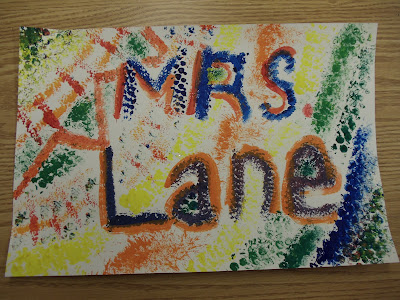In this lesson students focused on learning the methods utilized in watercolor painting. For motivation, the book The Rainbow Fish by Marcus Pfister was used. The students were told that they were going to be creating their own rainbow fish to celebrate sharing (the theme of the story). To start off the lesson the teachers taught what warm and cool colors were. Then a discussion of the various methods used in watercolor painting was presented. The teachers explained what flat wash (painting a section one continuous color), graduated wash (the color gradually moves from light to dark or dark to light), wet-in-wet (painting on wet paper), and watercolor resists (using a substance that resists the watercolor paint such as crayons before painting) were and how they were used in watercolor painting. Also, during this part of the lesson students were allowed to practice each method, along with practicing using watercolor crayons. After this, the students were allowed to begin painting their project. The requirements of the project were that they had to use at least two elements, two watercolor methods, and opposing color schemes on the background and fish (warm vs. cool). They were asked to paint the background first so that it would have more time to dry. During the work time, the teachers played a YouTube video of the book The Rainbow Fish, and the students seemed to enjoy that. Once their background was done they could work on their fish. To save time, the teachers precut the fish for the students. At the end of the class, students were allowed to glue the two together to finish their project.
An extension activity for this lesson would be to have an ocean unit. In this unit, students could create an ocean animal in the fashion of the above lesson. The student could then research the animal they created and find out facts about where it lives, eats, etc. Then, the student could write a story about that ocean animal. Each student could then share their project with the class and discuss why they chose the animal they did. Finally, after hearing about everyone else’s projects, the students could create another version of this project, only they would create their own sea creature that utilized their favorite aspects of the other students, thus pushing the students higher on Bloom’s Taxonomy.






